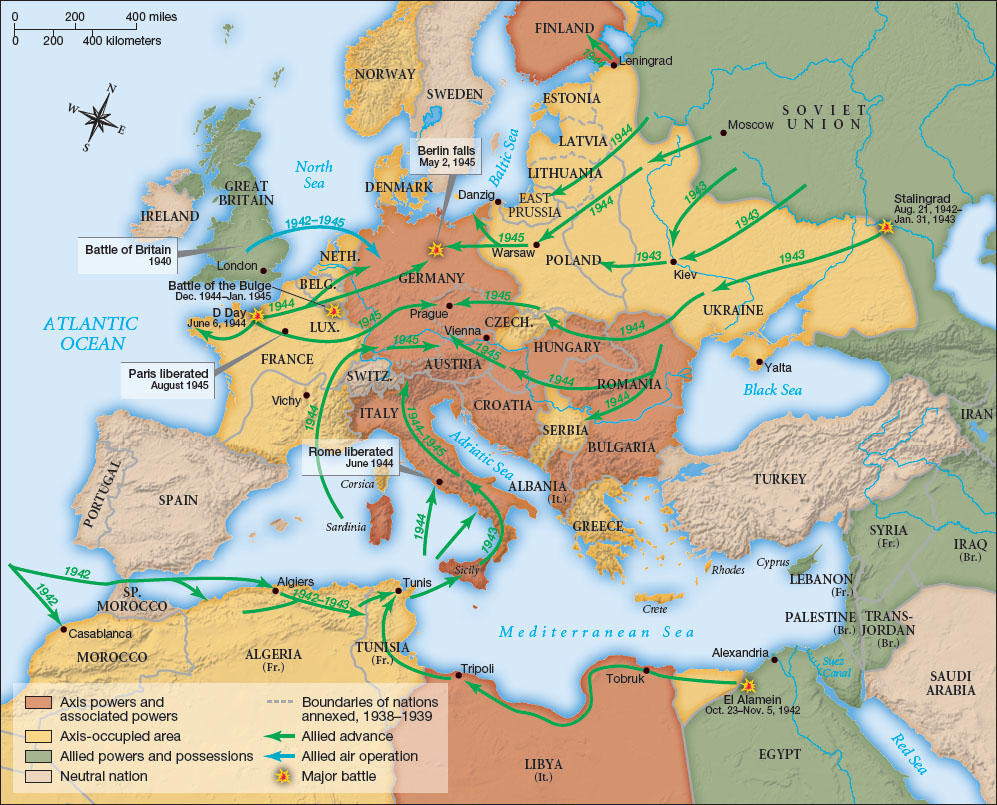Exploring American Histories: Printed Page 728
Exploring American Histories, Value Edition: Printed Page 598
War in Europe
United against Hitler, the Grand Alliance divided over how quickly to mount a counterattack directly on Germany. The Soviet Union, which bore the brunt of the fighting in trying to repel the German army’s invasion, demanded the speedy opening of a second front through France and into Germany to take the pressure off its forces. The British wanted to fight first in northern Africa and southern Europe, in part to remove Axis forces from territory that endangered their economic interests in the Mediterranean and the oil-rich Middle East and in part to buy time to rebuild their depleted fighting strength. President Roosevelt understood Soviet demands for immediately establishing a second front, but such a plan would involve fierce and bloody battles to attack the center of Axis strength. The president did not want to risk losing public support early in the war if the United States experienced heavy casualties. He approved his military advisers’ plans for an invasion of France from England in 1943, but in the meantime he agreed with Churchill to fight the Germans and Italians on the periphery of Europe.
From a military standpoint, this circuitous approach proved successful. In October 1942, British forces in North Africa overpowered the Germans at El Alamein, pushing them out of Egypt and removing their threat to the Suez Canal. The following month, British and American troops landed in Algeria and Morocco, controlled by the pro-Nazi French government, and under the British general Bernard Montgomery and the American general George S. Patton they engaged the desert forces of the German general Erwin Rommel. After some early defeats, the combined strength of British and American ground, air, and naval forces drove the Germans out of Africa in May 1943.
These military victories failed to relieve political tensions among the Allies. Although the Soviets had managed to stop the German offensive against Stalingrad, the deepest penetration of enemy troops into their country, Stalin expected the second front to begin as promised in the spring of 1943. He was bitterly disappointed when Roosevelt, hoping to replenish military resources that had been lost in North Africa, postponed the cross–English Channel invasion of France until 1944. To Stalin, it appeared as if his allies were looking to gain a double triumph by letting the Communists and Nazis beat each other into submission. Churchill’s strong anti-Communist beliefs fueled Stalin’s suspicions.
Instead of opening a second front in France, British, American, and Canadian troops invaded Italy from its southern tip in July 1943. Their initial victories quickly led to the removal of Mussolini and his retreat to northern Italy, where he lived under German protection (Map 23.1). Not until June 4, 1944, did the Allies occupy Rome in central Italy and force the Germans to retreat.

To overcome Stalin’s dissatisfaction with the postponement of opening the second front, President Roosevelt issued orders to give the Soviets unlimited access to Lend-Lease supplies to sustain their war efforts and to care for their citizens. In November 1943, the American president and the British prime minister met with the Soviet leader in Tehran, Iran. Roosevelt and Stalin seemed to get along well. Stalin agreed to deploy troops against Japan after the war in Europe ended, and Roosevelt agreed to open the second front within six months. Churchill joined Roosevelt and Stalin in supporting the creation of an international organization to ensure postwar peace.
This time the Americans and British kept their word, and the Allies finally embarked on the second-front invasion. Under the command of General Dwight D. Eisenhower, on June 6, 1944—called D Day—more than 1.5 million American, British, and Canadian troops crossed the English Channel in 4,000 boats and landed on the beaches of Normandy, France. Paratrooper landings behind German lines and naval bombardments supported this astonishing amphibious assault. Despite deadly machine-gun fire from German troops placed on higher ground, the Allied forces managed to establish a beachhead. The bravery and discipline of the troops, along with their superior numbers, overcame the Germans and opened the way for the Allies to liberate Paris in August 1944. By the end of the year, the Allies had regained control of the rest of France and most of Belgium.
Amid these Allied victories, Roosevelt won a fourth term against Republican challenger Thomas E. Dewey, governor of New York. He dumped from the campaign ticket his vice president, Henry A. Wallace, a liberal on economic and racial issues, and replaced him with Senator Harry S. Truman of Missouri, who was more acceptable to southern voters. Despite his declining health, Roosevelt won easily with 432 electoral votes and a margin of more than 3.5 million popular votes.